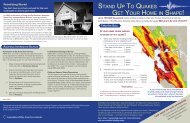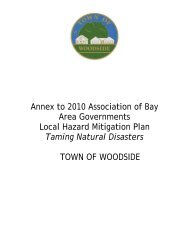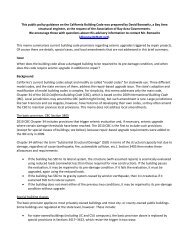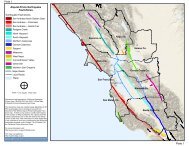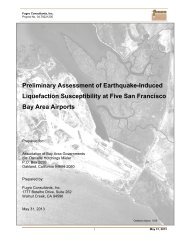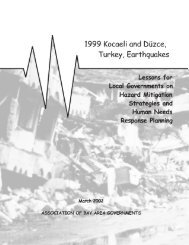Safe Enough to Stay - ABAG Earthquake and Hazards Program
Safe Enough to Stay - ABAG Earthquake and Hazards Program
Safe Enough to Stay - ABAG Earthquake and Hazards Program
- No tags were found...
Create successful ePaper yourself
Turn your PDF publications into a flip-book with our unique Google optimized e-Paper software.
Building evaluation <strong>and</strong> inspectionAfter a major earthquake, engineers <strong>and</strong> design professionals comefrom all over the country <strong>to</strong> help conduct formal building inspectionsusing what is known as the ATC-20 evaluation procedure. Theyevaluate building structures <strong>and</strong> tag them depending on their levelof damage: Red tags mean a building is unsafe <strong>and</strong> should not beentered or occupied; yellow tags indicate restricted use, meaning abuilding either requires further evaluation or is okay <strong>to</strong> occupy exceptfor designated areas; <strong>and</strong> green tags mean that no unsafe conditionswere found or suspected.Shelter-in-place evaluations are not a building tagging program;instead, they will provide immediate guidance for residents as <strong>to</strong>whether nonstructural <strong>and</strong> related conditions make a building suitableor unsuitable for continued occupancy. Residents will need <strong>to</strong> reviewshelter-in-place conditions within 24 hours of an earthquake so thatthey know whether they can remain in their homes. Meanwhile,it may take several days or weeks for inspec<strong>to</strong>rs <strong>and</strong> designprofessionals <strong>to</strong> undertake ATC-20 evaluations.Shelter-in-place st<strong>and</strong>ards need <strong>to</strong> be clear enough so that mostresidents will be able <strong>to</strong> assess their own buildings. But manyresidents will need help applying shelter-in-place st<strong>and</strong>ards <strong>to</strong> theirbuildings while they wait for design professionals <strong>to</strong> complete an ATC-20 evaluation. Community volunteers can be trained <strong>to</strong> help residentsdetermine if their home meets shelter-in-place st<strong>and</strong>ards.In many areas of the city, certain buildings will have minimal damagewhile neighboring buildings will be structurally unsafe. In buildingsthat appear <strong>to</strong> have substantial structural damage, residents will need<strong>to</strong> wait for a formal ATC-20 structural inspection by a designated cityinspec<strong>to</strong>r before sheltering in place.Enforcement of shelter-in-place st<strong>and</strong>ards <strong>and</strong> requirements for repairEnforcing shelter-in-place st<strong>and</strong>ards is key. The city should use itsenforcement power <strong>to</strong> ensure that property owners make repairs incompliance with the phased habitability st<strong>and</strong>ards described above.The responsibility rests with the property owner <strong>to</strong> provide for repairs<strong>and</strong> the res<strong>to</strong>ration of habitable conditions.Properties that are ab<strong>and</strong>oned or otherwise fail <strong>to</strong> meet legalrequirements for property repair, retrofit or maintenance shouldbe subject <strong>to</strong> the enforcement <strong>and</strong> abatement provisions of theapplicable San Francisco codes.Library of Congress Prints <strong>and</strong> Pho<strong>to</strong>graphs Division Lori Peekflickr user kosmosxipoKousaku Maeda, courtesy Kobe University LibrarySPUR Report > January 2012 29



